
Inside the dimly lit Main Hall, 1000 shining gold statues of the Thousand-Armed Kannon goddess stand in orderly rows. The mystical atmosphere makes this temple a popular hit among international visitors.
The temple is full of highlights, housing many national treasures such as the Main Hall and seated and standing statues of Thousand-Armed Kannon. It is also easy to get to, just a 10-minute bus ride from Kyoto Station or a mere 15 minutes on foot.
This article will introduce the best features of Sanjusangen-do Temple along with attractions in the surrounding area.
Sanjusangen-do: Japan's Longest Wooden Structure
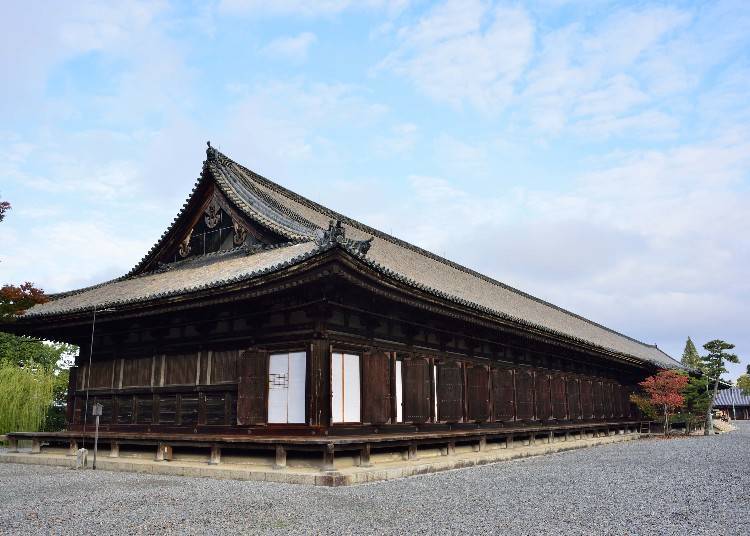
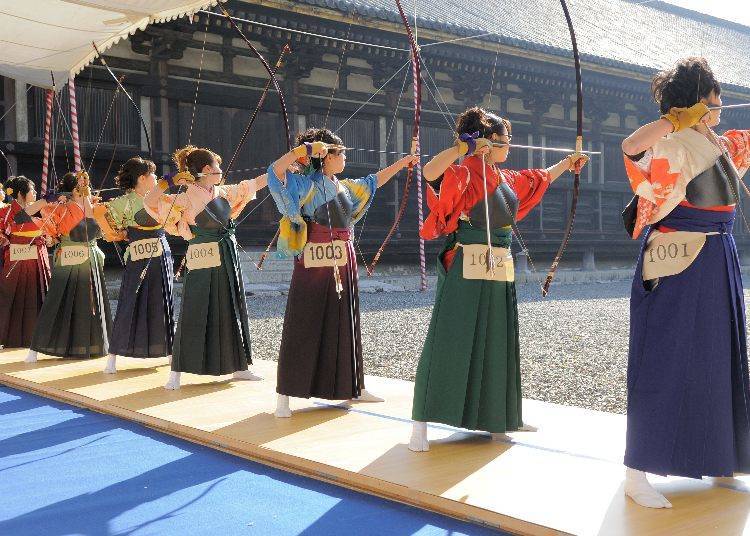
Sanjusangen-do Temple's official name is Rengeo-in Temple. The key to the mystery of the origin of its alias "Sanjusangen-do" lies in the temple's Main Hall, erected in 1164 by Taira no Kiyomori.
The long hall, the longest in Japan at 120 meters in length, has 33 spaces in-between its pillars, and that is said to be how the hall got its name, "Sanjusan," meaning "33".
The number 33 is also said to come from the 33 forms Kannon possesses. This Buddhist teaching is represented in the construction of the Main Hall. The original hall was later destroyed in a fire, and the current building was reconstructed in 1266.
The long Main Hall is also famous for long-range archery. Since the Momoyama period (the latter half of the 16th century), archery competitions were being held to see who could accurately shoot the most arrows over 120 meters from the southern tip of the west edge of the hall. Today, on the Sunday closest to January 15, an archery competition is held in honor of the Edo period long-range archery. In particular, seeing newly come-of-age young people dressed in fine clothing as they shoot is spectacular. This archery competition has become an indispensable and representative part of bringing in the New Year in Kyoto.
Thousand-Armed Kannon Statues Surround the Stunning Central Image
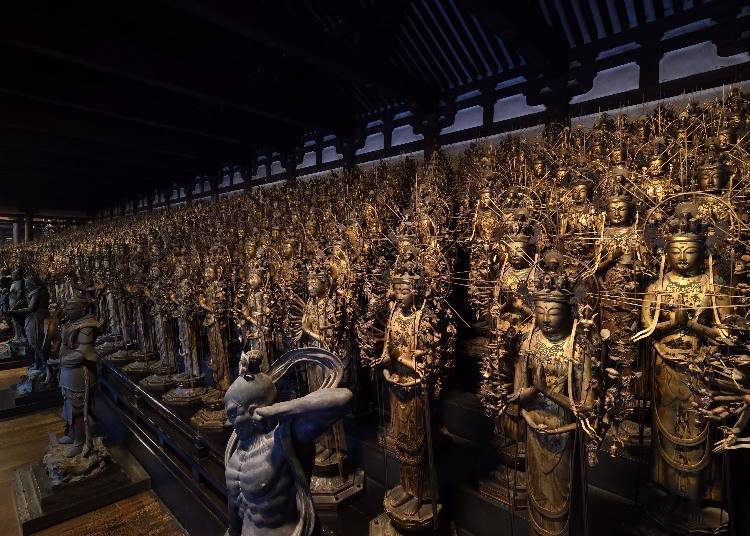
Inside the hall, the temple's principal image, a seated Thousand-Armed Kannon statue (a national treasure), is flanked by 500 standing Kannons on each side, for a total of 1000 enshrined statues (all national treasures).
Beginning with the "Dai-isson" statue on the highest level on the left, to the "Kigoku-son" statue in the bottom right corner, each of the 1000 statues have names. Each Kannon also has a different expression, and it is said that there's always a statue that looks like yourself or your loved one, so try looking for them.
In front of the standing Kannon statues are Nijuhachibushu (28 Legions, protecting the Kannon deity) and Fujin and Raijin (the gods of wind and thunder) statues as well. Every one of the hall's statues are masterpieces of Kamakura period sculpture and designated national treasures, and the realistic artwork is stunning. This army of Buddhist statues that seem like they could come alive at any moment is a must-see spectacle.
Myoho-in Temple
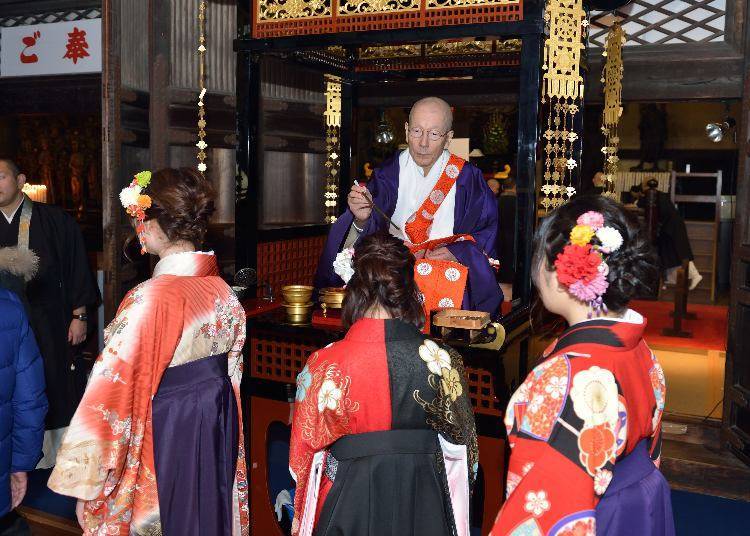
The "Rite of the Willow" ("Yanagi no Okaji"), which takes place on the same day as the archery competition and has its roots in India, is the most important ritual at Sanjusangen-do Temple. During the ritual, a branch of a sacred willow tree is used to sprinkle blessed water onto attendees' heads, which is said to ward off illness and prevent headaches in particular.
The temple is said to have been built in prayer of recovery from the chronic headaches Emperor Go-Shirakawa suffered. The temple is also known by the nickname "Zutsu-zan Heiyu-ji" ("headache mountain temple of recovery"), and there are omamori charms sold to cure and protect against headaches as well.
On the day of the Rite of the Willow, entry to the temple grounds is free, and the statues of the Main Hall can be viewed for free. The temple is exceptionally crowded and lively on that day between all those coming to receive a blessing and those who watch or participate in the archery contest.
The Shuntoue Festival is Packed with Celebratory Activities and Events
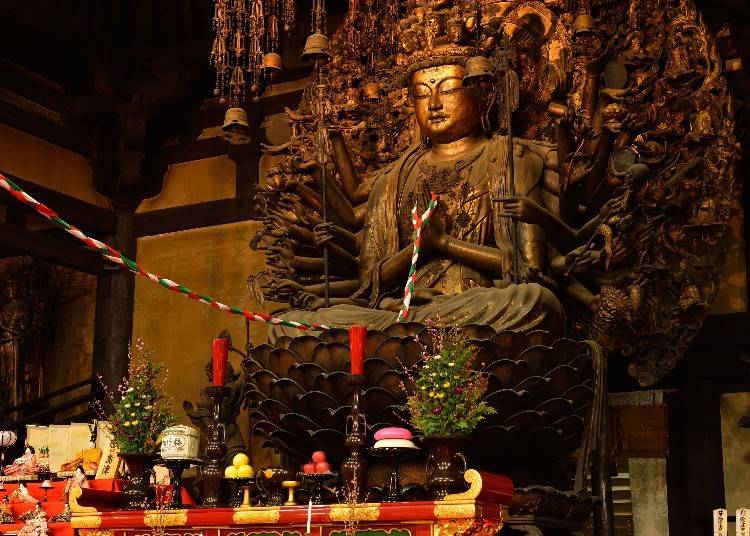
Based on the significance of the number three in Sanjusengen-do Temple's name, on March 3 (3/3), the Shuntoue festival is held. During this festival, also known as "Momonohoue," there are many celebratory events, including floral offerings and exhibitions of the Ikebono school of flower arrangement, howa (religious teachings) and rakugo (comic story) tellings, and more.
On this day only, a special platform is set up on the pathway of the Main Hall to get a bird's eye view of the Thousand-Armed Kannon statues, which brings in many visitors hoping to view the statues from a unique angle and a sweeping view of the entire hall.
In honor of the traditional "Momo no Sekku" ("Peach Festival") on March 3, peach omamori (500 yen) are sold, available only to women and girls. Like the day of the Rite of the Willow, entry to the temple is free on this day, so there is always a lively crowd.
Many More Sights to See in the Higashi-Nanajo Area
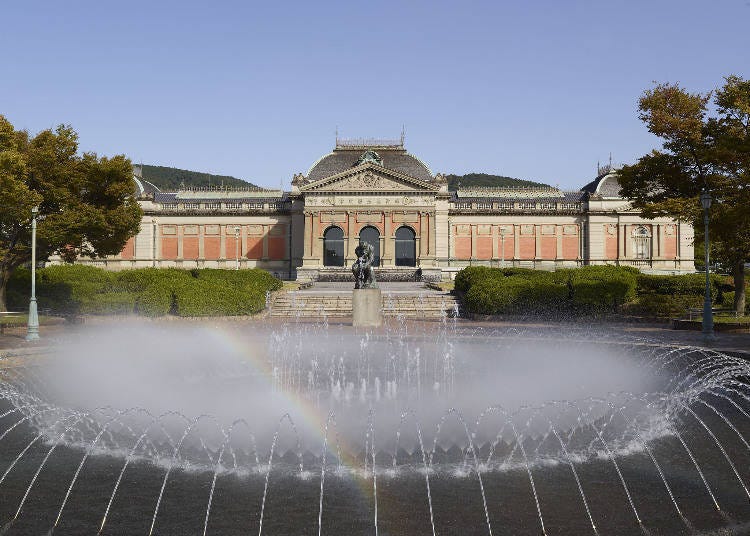
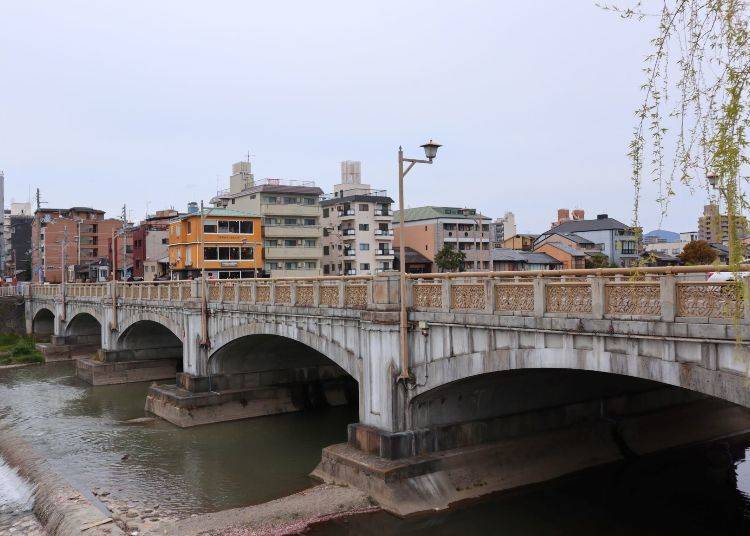
The Higashi-Nanajo area where Sanjusangen-do Temple is located has many great spots for sightseeing. Hojujidono Temple, where cloistered Emperor Go-Shirakawa resided, was once located here. Today there are several shrines and temples related to Hojujidono Temple, including Hoju-ji Temple, Imahie-jingu Shrine, and Myoho-in Temple.
There are also many spots related to the historic figure Toyotomi Hideyoshi, including Toyokuni Shrine, which commemorates Toyotomi, and Hodai-ji Temple, home to the Great Buddha Hall built by him. The Kyoto National Museum across from Sanjusangen-do Temple is also an attraction you won't want to miss.
Aside from exhibits, the museum also features many interesting places to check out, such as the main gate constructed in the Meiji era, Meiji Kotokan Hall, and a large garden. Shichijo-oohashi Bridge crossing the Kamo-gawa River was completed in 1913 and, in 2018, registered as a national tangible cultural property. Try taking a tour around the Higashiyama-Nanajo area to see its many highlights.
Etiquette When Visiting Sanjusangen-do Temple
Photography is forbidden inside the Sanjusangen-do Main Hall, and you may not photograph any of the statues. Shoes are also forbidden in the Main Hall. The Main Hall path is narrow, so if you want to stop and look at a statue, you must take care not to block the path.
*Main photo: Myoho-in Temple
-

-
Address
657, Sanjusangendomawaricho, Higashiyama-ku, Kyoto-shi, Kyoto, 605-0941
View Map -
Nearest Station
Shichijo Station (Keihan Line)
7 minutes on foot
- Phone Number 075-561-0467
-
Address
657, Sanjusangendomawaricho, Higashiyama-ku, Kyoto-shi, Kyoto, 605-0941
Text by:word
Related Articles on Visiting Kyoto
- Area
- Category
*Prices and options mentioned are subject to change.
*Unless stated otherwise, all prices include tax.
Popular Tours & Activitiess
Recommended places for you
-

Jukuseiniku-to Namamottsuarera Nikubaru Italian Nikutaria Sannomiya
Izakaya
Kobe, Sannomiya, Kitano
-

Kambei Sannomiyahonten
Yakiniku
Kobe, Sannomiya, Kitano
-
Goods
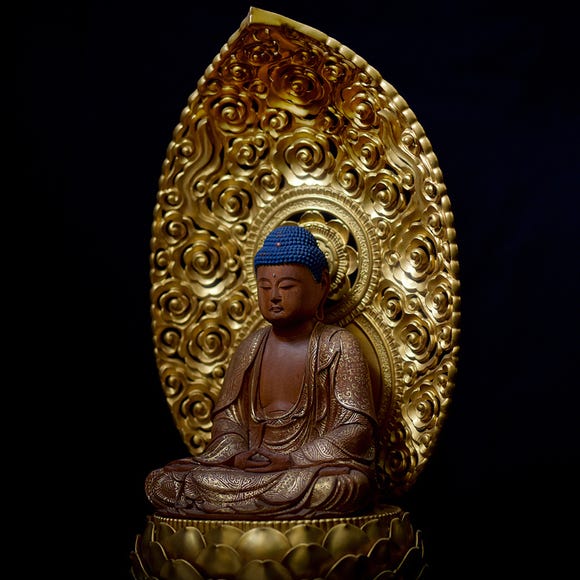
Yoshida Gennojo-Roho Kyoto Buddhist Altars
Gift Shops
Nijo Castle, Kyoto Imperial Palace
-

ISHIDAYA Hanare
Yakiniku
Kobe, Sannomiya, Kitano
-

To-ji Temple
Temples
Kyoto Station, To-ji Temple
-

Kanzenkoshitsuyakinikutabehodai Gyugyu Paradise Sannomiya
Yakiniku
Kobe, Sannomiya, Kitano
-

A First Look at NEMU RESORT’s 2026 Grand Renewal in Ise-Shima: A Resort Shaped by Village, Sea, and Forest
by: Guest Contributor
-

Kyoto's Hidden Treasures Open This Winter! Enjoy Exclusive Access to 15 Rare Cultural Sites (Jan-Mar 2026)
by: Guest Contributor
-
Ad

Discover Timeless Beauty: Kimono-en, a Web Magazine Exploring the Spirit of Kimono
-

Celebrate a Dreamy Barbapapa Christmas at JR Osaka Station's Twilight
by: Guest Contributor
-
Ad
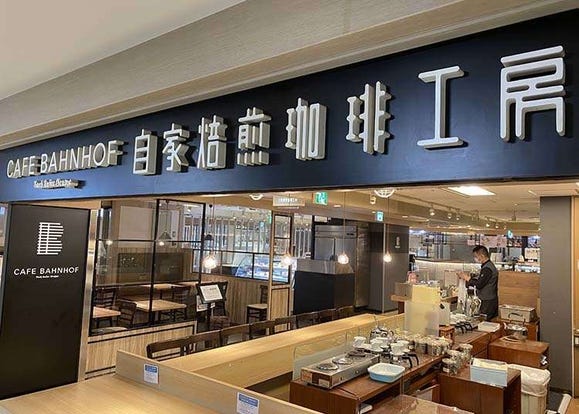
Café Bahnhof in Osaka: The home-roasted coffee that captivated G20 leaders!
-

New Way to Reach Koyasan! Ride Nankai's 'GRAN Tenku' for a Heavenly Journey
by: Guest Contributor
Inspiration for Accommodations
-

Spacious Family Hotel in Namba: 20 Comfortable Stays for Family Fun
-
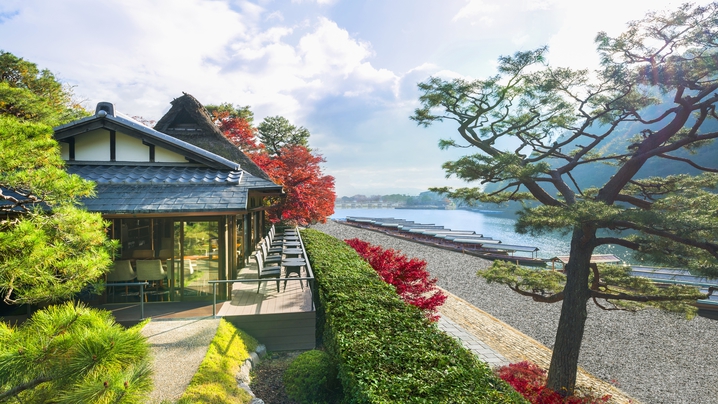
Charming Hotels to Enjoy the Spectacular Views of Arashiyama's Autumn Leaves from Your Room
-

Experience Stunning Views of Osaka Castle from Private Spaces: Top Hotels Near Osaka Castle
-
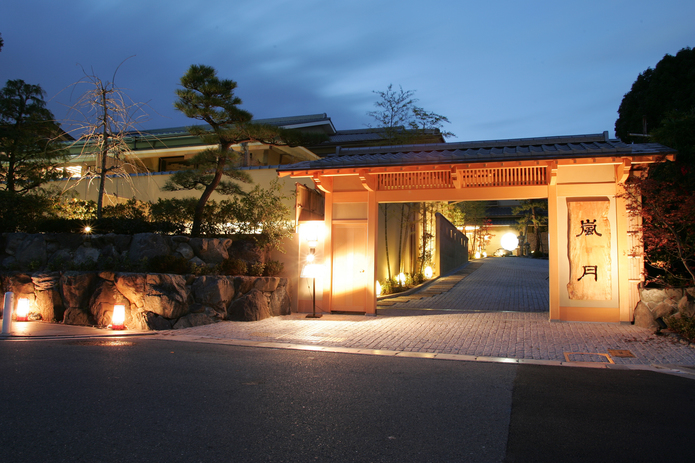
Recommended by Visitors! Arashiyama's Best-Rated Hotels
-

Family-Friendly Universal Studios Japan Hotel with Excellent Access
-
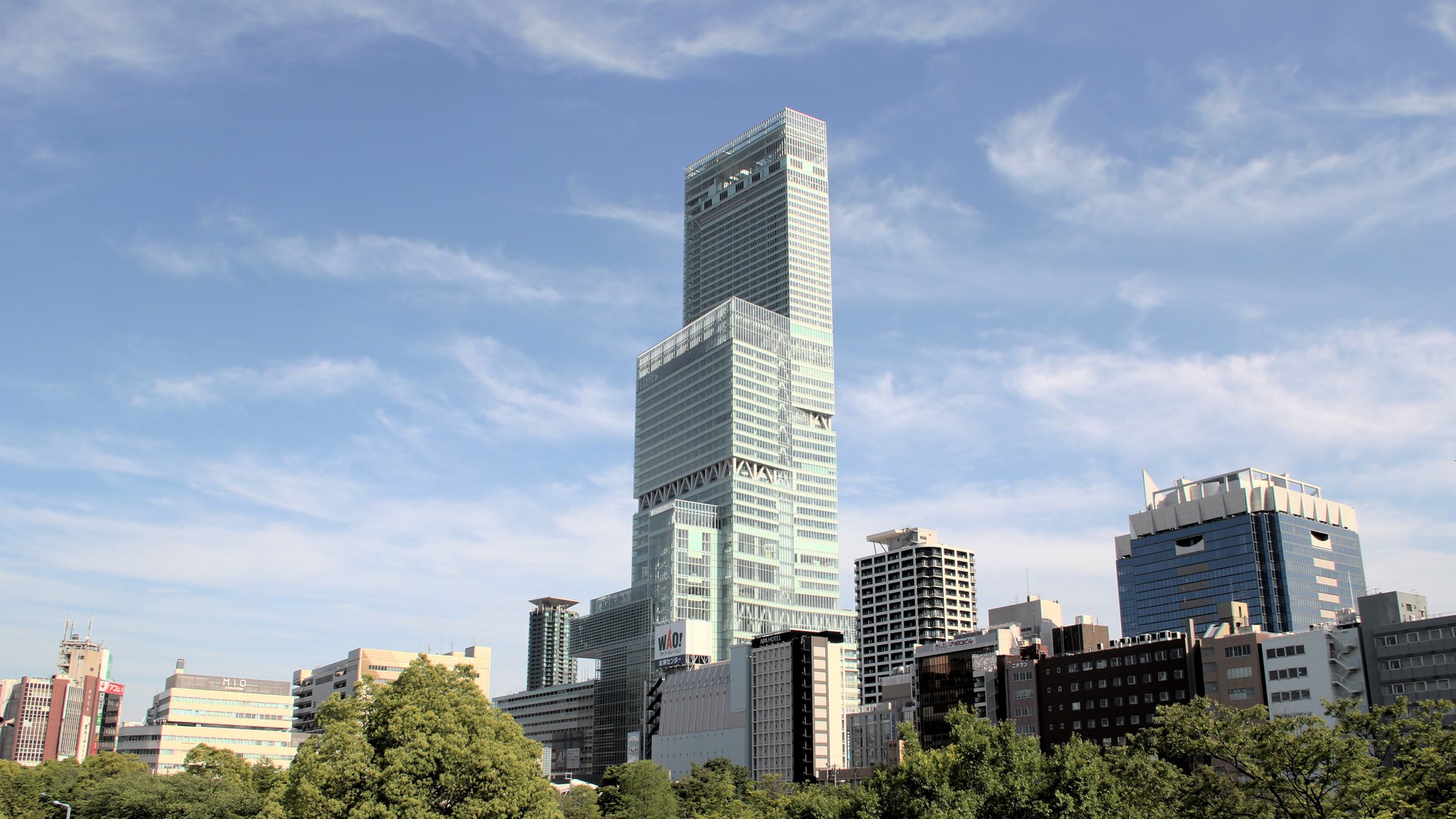
Enjoy a Comfortable Stay in Osaka! 10 Hotels with Convenient Airport Shuttle Services
-

Top 10 Recommended Hotels Near Namba Station with Great Access
-
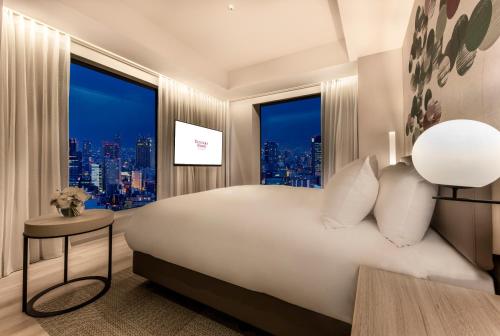
Enjoy Night Views from Your Room! Recommended Hotels in Namba Area
-

Why Osaka Tennoji Zoo is So Popular with Foreign Tourists (Guide & Highlights)
-

Visiting Nara's Hasedera Temple: This 'Temple of Flowers' Is Home to Stunning Statues!
-

Beyond Stunning! Kyoto’s Most Gorgeous Temples Explored!
by: Steve Csorgo
-

Rakusai: A Pilgrimage to the Green of Western Kyoto
-

Osaka Koreatown: In Search of the Best Eats in the Korean Roots of Osaka's Tsuruhashi Market
-

10 Most Popular Temples in Nara
- #best gourmet Osaka
- #things to do Osaka
- #what to do in kyoto
- #what to bring to japan
- #best gourmet Kyoto
- #new years in Osaka
- #what to buy in nanba
- #Visiting Osaka
- #onsen tattoo friendly arima
- #daiso
- #Visiting Kyoto
- #best japanese soft drinks
- #japanese fashion culture
- #japanese convenience store snacks
- #japanese nail trends













